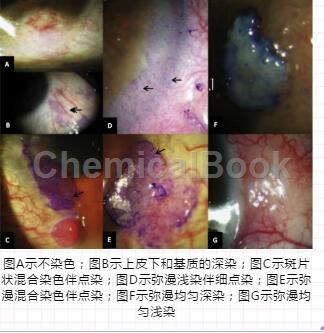Ocular surface squamous cell tumors include simple atypical hyperplasia of the corneal and conjunctival epithelium, carcinoma in situ, and invasive squamous cell carcinoma. Currently, clinical diagnosis is often made through clinical manifestations, but the accuracy is limited. Due to the popularity of topical medications for the treatment of ocular surface squamous cell tumors, histopathological examination is not widely used as the gold standard for diagnosis. Conjunctival impression cytology, as a minimally invasive technique for detecting ocular surface squamous cell tumors, is not only cheap, fast, but also highly accurate. However, an article published in The Ocular Surface found that toluidine blue staining, a more convenient and faster diagnostic method, is comparable to conjunctival impression cytology. Let’s find out.
Toluidine blue staining has high diagnostic sensitivity and specificity!
Principle of toluidine blue staining: Toluidine blue can selectively stain acidic tissue components such as nucleic acids, and has high affinity with malignant mucosal epithelial cells, so it can be used for the examination of oral cavity, cervical and gastrointestinal epithelial neoplasia. .
Research design: The researchers took advantage of this characteristic of toluidine blue to stain a total of 88 eyes of 82 patients with 1% toluidine blue, and conducted experiments on the color depth, staining method and staining distribution of the lesions. Score, if the score is greater than or equal to 5 points, it is positive. Comparing the staining results with the conjunctival impression cytology results, it was found that 43 of the 45 eyes with positive toluidine blue staining also showed cellular atypia in the impression cytology examination. The sensitivity of toluidine blue staining for ocular surface squamous cell tumors is 86%, the specificity is 94.74%, the positive predictive value is 95.56%, and the negative predictive value is 83.72%.

Dark staining and/or mixed staining of spot stains indicates cancer!
Lesions can be divided into non-staining (0 points), light staining (1 point), dark staining (2 points) and mixed staining (2 points) according to different staining intensities; according to the staining method, they can be divided into even staining (1 point) and spot staining (2 points); according to the staining distribution, it is divided into scattered staining (1 point), patchy staining (2 points) and diffuse staining (3 points). Spot-stained hyperstained and/or mixed stained lesions were found to correlate best with impression cytology results.
Beware of false positives from toluidine blue staining!
Two cases of false-positive staining were found in the study, one was a melanotic nevus with severe squamous metaplasia, and the other was a cured sebaceous cell carcinoma. The use of conjunctival impression cytology cannot be ignored in complex cases because inflammatory cells, mucin, hyperkeratosis, ulcers, and granulation tissue can all bind to the stain and may result in false positives.
Small summary
1. Toluidine blue staining can be used as a diagnostic test for ocular surface squamous cell tumors.
2. During diagnosis, you can focus on observing the color depth of staining and the type of staining.

 微信扫一扫打赏
微信扫一扫打赏

